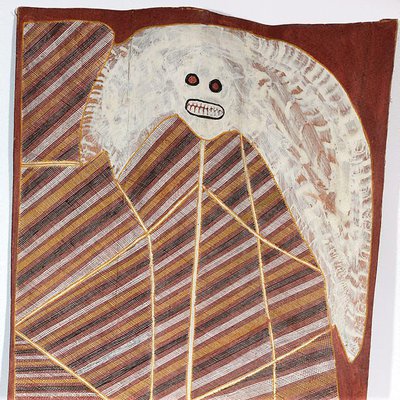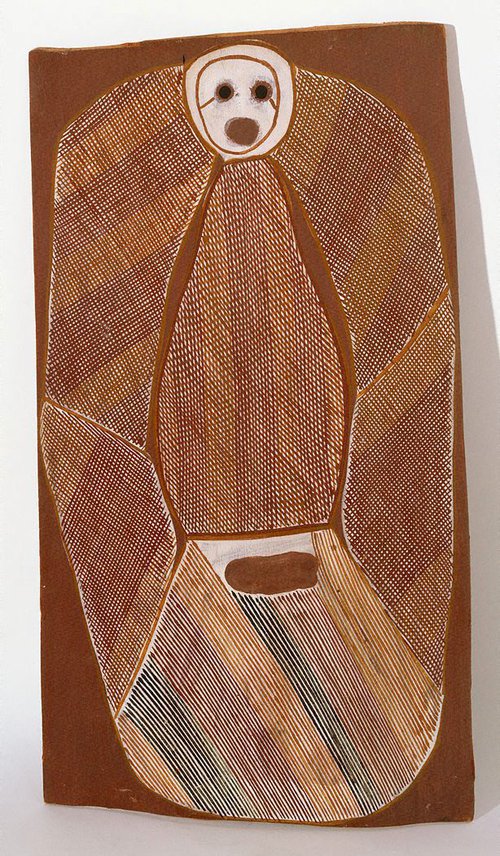Title
Yawkyawk
2000
Artist
-
Details
- Other Titles
- Yawk Yawk figure
Yawkyawk figure - Places where the work was made
-
Mumeka
→
Western Arnhem Land
→
Northern Territory
→
Australia
Kurrurldul → Central Arnhem Land → Northern Territory → Australia
- Cultural origin
- Maningrida Arts and Culture
- Date
- 2000
- Media category
- Bark painting
- Materials used
- natural pigments on eucalyptus bark
- Dimensions
- 157.0 x 63.0 cm (irreg.)
- Signature & date
Not signed. Not dated.
- Credit
- Mollie Gowing Acquisition fund for Contemporary Aboriginal art 2001
- Location
- Not on display
- Accession number
- 446.2001
- Copyright
- © Estate of Jimmy Njiminjuma/Copyright Agency
- Artist information
-
 Jimmy Njiminjuma
Jimmy Njiminjuma
Works in the collection
- Share
-
-
About
Jimmy Njiminjuma is currently one of the most senior artists in the western Arnhem Land region. For many years he lived with his father, Anchor Kulunba, at Mumeka outstation. Njiminjuma says that his father and his uncle Peter Marralwanga showed him how to paint. In the 1980s Njiminjuma took a strong role in teaching his younger brother John Mawurndjul the art of bark painting. Njiminjuma has now established an outstation at Kurrurldul on Mimarlar Creek, a tributary of the Tomkinson River, south of Maningrida.
Njiminjuma is adept at painting a number of subjects, and one of his recurring themes is the yawkyawk. These figures are understood to be a kind of female water sprite, and the Kuninjku often paint them with the forked tail of a fish and long flowing hair likened to the trailing waterweed of freshwater streams. In 'Yawkyawk', 2000, Njiminjuma depicts the form of the spirit being, embedded in the sacred landscape of Milmingkan, in his clan lands. The rarrk (crosshatched) designs at the left of the painting represent the banks of the waterhole, and the fork-tailed figure is shown outlined against a field of rarrk that represents the site.
Part of the creativity in Njiminjuma's painting is evident in his ability to construct complex figures that merge with the geometric background designs. These designs have their basis in the body paintings of the Mardayin ceremony, in which the participants are marked with images of the landscape that is their birth heritage. In bark paintings, the incorporation of geometric designs and figurative elements reveals Kuninjku beliefs in how certain landscape forms were moulded by the creative actions of ancestral beings. The ancestral beings entered the earth at these special places and exist there still as an animating life force.
Luke Taylor in 'Tradition today: Indigenous art in Australia', Art Gallery of New South Wales, Sydney, 2004
© Art Gallery of New South Wales
-
Exhibition history
Shown in 3 exhibitions
Crossing country: the alchemy of Western Arnhem Land art, Art Gallery of New South Wales, Sydney, 24 Sep 2004–12 Dec 2004
Country Culture Community (2008-09), Art Gallery of New South Wales, Sydney, 12 Nov 2008–19 Apr 2009
Our spirits lie in the water, Art Gallery of New South Wales, Sydney, 15 Nov 2014–01 Nov 2015
-
Bibliography
Referenced in 4 publications
-
Art Gallery of New South Wales, Art Gallery of New South Wales Annual Report 2002, 'Year in review', pg. 8-25, Sydney, 2002, 9.
-
Hetti Perkins, Crossing country: the alchemy of western Arnhem Land art, Sydney, 2004, front cover (colour illus., detail), 77 (colour illus.), 229.
-
Public Programmes Department, Art Gallery of New South Wales, Crossing country: the alchemy of western Arnhem Land art, 'Site and subject', Sydney, 2004, (colour illus.).
-
Luke Taylor, Tradition today: Indigenous art in Australia, 'Jimmy Njimimjuma', pg. 112, Sydney, 2004, 112 (colour illus.), 113 (colour illus., detail).
-





